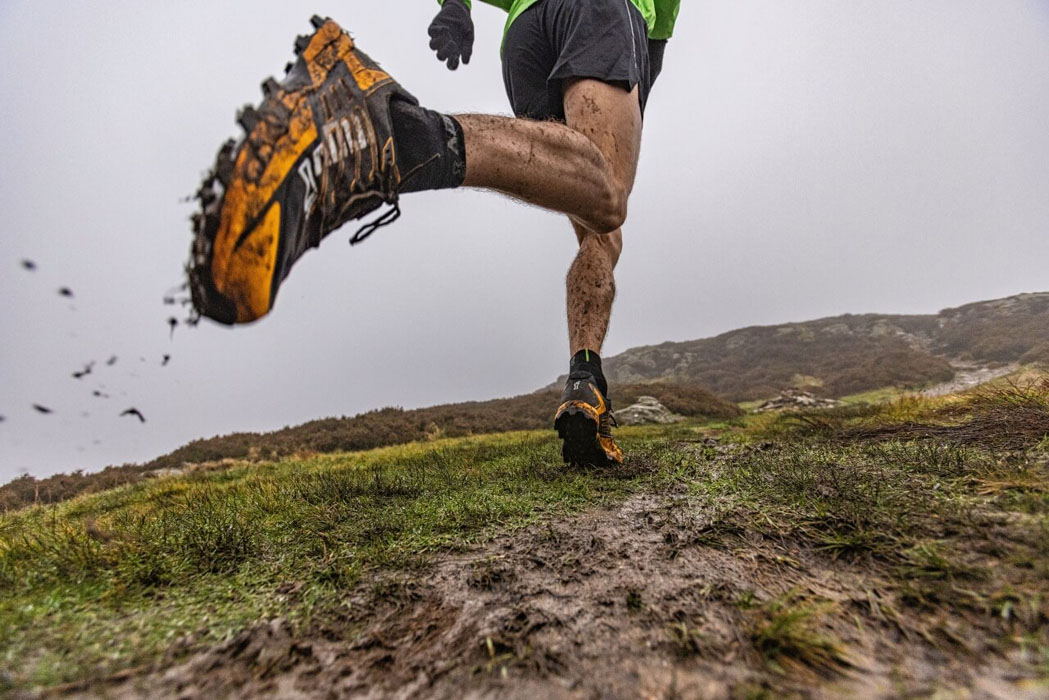
Looked after properly, a good pair of trail running shoes should last you several hundred miles or more. While some shoe manufacturers will say to replace your shoes every 300-500 miles, there are many factors that influence how long they will last – not least the durability of the shoe itself and how you care for them. Indeed, we regularly see cared-for INOV8 footwear double the mileage stated by some shoe manufacturers.
We design footwear with this in mind, and we’re proud to be known for the durability of our trail running shoes. But there’s also plenty you can do to make your trail running shoes last as long as possible. You’ll also find in this guide a whole range of ideas for when your shoes are coming to the end of their (running) life.
HOW TO PROLONG THE LIFE OF YOUR TRAIL RUNNING SHOES
Simply looking after your shoes properly can add hundreds of miles to their lifespan. Squeezing the most out of them is not only better for your bank balance, but also for the environment too.
Here are our top tips to keep your trail running shoes in good shape:
- Keep two pairs on rotation
This might seem counter-intuitive, but having two pairs of trail running shoes on rotation will mean that your shoes have the time to properly “recover” between runs. This will allow your shoes to air and dry out. Having two pairs on the go at once will extend the lifespan of both. - Clean your shoes after muddy runs
Washing your shoes after a muddy run is much more important than simply keeping them looking nice! Over time, caked mud on the upper of your shoes can cause the upper material to become rigid, weaken and eventually break apart. For the five minutes it takes to clean your shoes, it’s well worth the effort. - Allow your shoes to dry out properly
After washing your shoes, or particularly following wet/muddy runs, it’s important to let your shoes dry out fully before running in them again. - Keep your running shoes for running
Using your shoes only for running will obviously mean that you can get more running miles out of them. While it can be tempting to wear your running shoes casually, it will reduce their running life. An old, retired pair of running shoes are perfect for casual wear – so keep your current runners for running! - Buy for durability
Although pretty much all running shoes end up in landfill at present, there are companies trying to make shoes out of more durable and sustainable materials. Longer lasting shoes = less environmental impact. At INOV8 we’re well known for the durability of our shoes, using the world’s toughest grip, graphene, in many of our trail running shoes. More recently we’ve infused graphene into the foam cushioning on some of our models, again with the intention of making them last longer. - Repair ripped uppers
Sometimes the upper of trail running shoes can rip – either through the creases that naturally form from lots of wear, but also from the trail itself (rocks, thorny vegetation, etc.). If they rip, it isn’t the end! We love Pair Ups – they send you a patching kit through the post so your shoes can wear their rips as badges of honour. The founder of Pair Ups got a further 300 miles from his INOV8 shoes after patching them! - Consider re-soling
You’d re-sole an old pair of shoes, so why not re-sole a pair of fell or trail running shoes? Many local cobblers will be able to re-sole running shoes nowadays – it’s worth asking, and obviously far cheaper than buying a new pair.
WHEN TO REPLACE YOUR TRAIL RUNNING SHOES
There isn’t a set number of miles you will get out of your trail running shoes. Many people think that you need to replace your shoes every 300-500 miles, but this isn’t necessarily the case.
The key things to consider are the wear on the sole of the shoe, and how your legs feel when wearing them. Clearly if the sole has worn through, or the shoes no longer have the grip to help you move fast over the trails, then it might be time for a new pair.
Equally if you’re getting new aches and pains when you run in your shoes, it may mean it’s time to invest. We say may because there could be many factors at play here – not least training volume and intensity, the terrain you’re running on, etc.
GIVE YOUR OLD SHOES A NEW LIFE
Alas, all running shoes will no longer be suitable for running. And “recycling” options for them are very limited at present. We’re currently working on an exciting project regarding how to direct old shoes into a new lease of life as something else... watch this space!
In the meantime, here are a couple of options for running shoes that are reaching the end of the trail:
- Continue to wear them for other things
The great thing about running shoes, is that they’re some of the comfiest shoes you will wear. So when they’re coming up to retirement, why not keep them going? Old running shoes are perfect for casual wear, as gardening shoes, decorating shoes, school run shoes, watching your kids play football on a muddy pitch shoes… the list is endless! - Light duties?
Are your trail running shoes completely done? Or can they carry on a little bit more? Could they be used for light duties – short recovery runs, or reserved for really muddy/boggy training runs to preserve a newer pair of shoes?
